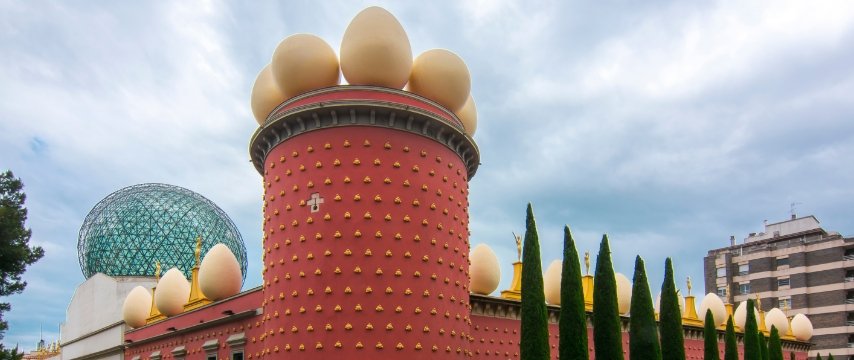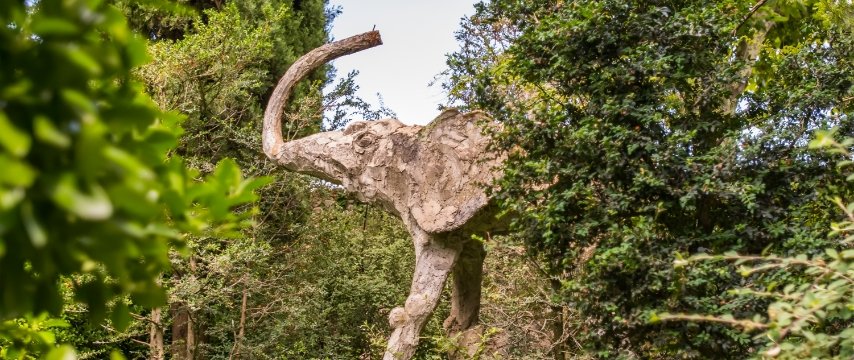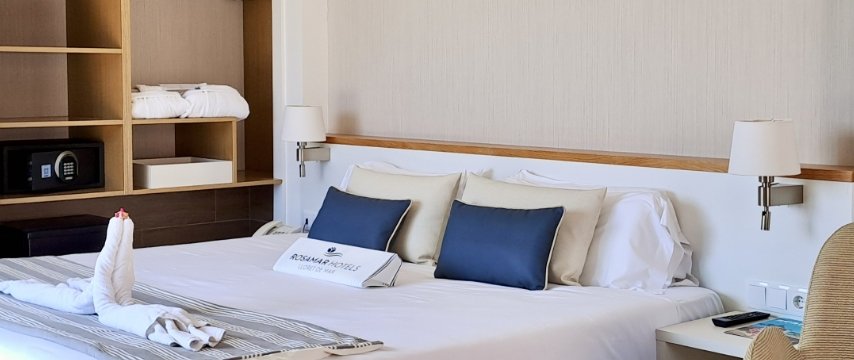

The Dalinian Triangle is an essential journey for lovers of surrealist art and Salvador Dalí himself. Formed by three unique spaces on the Costa Brava and its surroundings —the Dalí Theatre-Museum in Figueres, the Salvador Dalí House-Museum in Portlligat (Cadaqués), and the Gala Dalí Castle in Púbol— this itinerary allows visitors to delve into the artist’s life, creativity, and eccentric personality. Each site offers a different experience: from the visual explosion of the museum, through the intimacy of his seaside home, to the historical elegance of the castle he gifted to Gala.
Exploring the Dalinian Triangle is much more than visiting museums; it is a journey through Dalí’s imagination, where every corner reflects his surrealist world, his relationship with Gala, and the inspiration he drew from the Costa Brava’s landscapes. This tour combines culture, history, and art, becoming a unique experience for all kinds of visitors.
Thanks to the proximity of these three landmarks and the possibility of combining them in one or several days, it is the perfect plan for those staying in Lloret de Mar who wish to discover how Dalí’s genius transformed these sites into world-renowned art destinations.
The Dalí Theatre-Museum, located in the heart of Figueres, is the cornerstone of the Dalinian Triangle and one of the most visited museums on the Costa Brava. Built on the ruins of the old municipal theatre, it is the largest surrealist object in the world. A space where every corner surprises and immerses visitors in Dalí’s creative universe.
Inside, you can admire works from all his periods, from his early days to his final creations. Among the most iconic pieces are the Mae West Room, where a set of furniture recreates the actress’s face; the Wind Palace, with a monumental ceiling painted by the artist himself; and the Dalí Jewels collection, featuring pieces designed with his unmistakable surrealist touch. The visit culminates in one of the most striking corners: Dalí’s crypt, where the genius rests.
The museum is about 80 kilometers from Lloret de Mar. It can be reached by public transport: from Lloret de Mar there are buses to Girona, and from there, trains to Figueres-Vilafant station, about 15 minutes by taxi or bus from the museum. Due to its enormous popularity, especially in high season, tickets should be booked in advance. To fully enjoy it, dedicate at least half a day, as the visit is extensive, detailed, and designed to captivate all the senses.

The Salvador Dalí House-Museum, located in the small bay of Portlligat, in Cadaqués, was the artist’s home and workshop for more than 40 years alongside his muse Gala. This intimate space is key to understanding his creative process, as the Mediterranean setting, the light of the sea, and the peaceful landscape became his main source of inspiration and the refuge where he developed much of his work.
What began as modest fishermen’s huts gradually grew organically over time, adapting to the painter’s needs. Inside, you can still find his painting studio, the library, personal rooms, and spaces decorated with extravagant objects reflecting his eccentric character. The visit ends in the outdoor gardens, where surrealist sculptures and unique corners transport visitors into an artistic universe that fuses art and daily life.
The house is about 37 kilometers from Figueres. Although the most convenient way to get there is by private vehicle, it is also possible to reach it by public transport, combining intercity buses from Figueres and Girona. However, it is essential to plan the day well, as the journey can take nearly a whole day.
The visit is organized in small groups and with specific time slots, making advance booking essential. Arriving early also allows you to enjoy Cadaqués, one of the most picturesque villages on the Costa Brava.
The Gala Dalí Castle, located in the quiet village of Púbol, is perhaps the most enigmatic site of the Dalinian Triangle. Dalí bought it in the 1960s and turned it into a gift for his muse Gala, with one surreal yet symbolic condition: he could only visit her there if he had written permission from her.
This medieval castle, carefully restored by the artist, reflects the fusion of history and creativity. Its rooms are decorated with murals, sculptures, intervened furniture, and unique details that bear Dalí’s unmistakable mark. During the tour, you can also admire Gala’s haute couture dresses as well as the room where she spent the last years of her life. The garden, filled with surrealist figures and elements, immerses visitors in an intimate and nostalgic atmosphere, very different from the creative explosion of the Theatre-Museum or the vibrant luminosity of Portlligat.
The castle is about 40 kilometers from Figueres, making it an easy visit to combine with the Dalí Theatre-Museumin a single day. Although it is possible to take a train to Flaçà, 5 km from Púbol, and then a taxi to the Gala Dalí Castle, the most convenient and flexible option is still private transport, as there is currently no direct public connection to the village. Being a less crowded site than the other two, it allows visitors to take their time and enjoy the authenticity of the surroundings.

To make the most of the Dalinian Triangle, plan your visit in advance. The most convenient way to explore all three sites is by car, although it is also possible to reach Figueres by train and combine local buses to Cadaqués and Púbol.
All tickets require online booking, especially the Salvador Dalí House-Museum in Portlligat, which operates with small groups. Dedicate at least half a day to the Dalí Theatre-Museum, and between one and two days if you want to complete the entire triangle.
Check the accessibility of each site, as some have limitations, and plan your visit in spring or autumn to enjoy pleasant temperatures and fewer crowds. With these tips, your journey into Salvador Dalí’s universe will be complete and unforgettable.
After exploring the places where Dalí left his mark, there is nothing better than relaxing at Rosamar Hotels in Lloret de Mar, located right on the beachfront.
For those seeking peace and quiet, Hotel Rosamar Es Blau Adults Only +21 and Hotel Rosamar Maxim Adults Only +21 offer spa, pool, and terraces with sea views.
If you are traveling with family, Hotel Rosamar Garden Resort guarantees fun with slides and activities for children, while Hotel Rosamar & Spa and Hotel Rosamar Maritim combine comfort, gastronomy, and spectacular Mediterranean views.
Staying at Rosamar Hotels is not only the perfect complement to a cultural trip, but also the ideal way to enjoy relaxation by the sea after a day exploring Salvador Dalí’s universe.

The Costa Brava hides a great diversity of towns that have managed to preserve their charm, character, and attractiveness over the years. Get ready to fall in love with these five destinations that you must know on your next visit to the Costa Brava!
From the mountains of the Pyrenees to the rugged and idyllic Costa Brava, the province of Girona has all kinds of landscapes. Inside there are towns that seem to be taken from a fairy tale. Discover some of these charming towns in the interior of the province of Girona!
The Catalan region of the Empordà enjoys unique geoclimatic conditions for growing vines due to its proximity to the Mediterranean Sea. Discover in this post no more and no less than fifteen wineries in the north of the Empordà to visit and do a wine tasting!
Can Font, also known as Cal Conde or Can Piuet, is a modernist-style building in Lloret de Mar built in 1877 by the Lloret-born Fèlix Torras i Mataró, commissioned by Nicolau Font i Maig. Everything you didn't know about the only Indian-style house-museum in Catalonia!
Do you want to know how the Iberians lived in Lloret de Mar? You can do it at Can Saragossa, an old farmhouse that houses permanent exhibitions on how the Iberians lived in the municipality. Discover it!
The Castle of Sant Joan is an 11th century fortification that is located on a cliff sixty meters high that separates the beaches of Lloret de Mar and Fenals, making it a magnificent space to enjoy fantastic panoramic views of Lloret de Mar.
The church of Sant Romà is one of the most representative buildings in the town. It is located in the centre of Lloret de Mar, in the Plaça de l'Església. The building is in Gothic style, but its two side chapels are in the Art Nouveau style and use the trencadís technique.
Discover the Castle of Lloret de Mar, a 20th century architectural gem. Perched on cliffs and surrounded by natural beauty, this emblematic castle offers an unparalleled visual experience, soak up its history and marvel at its charm!